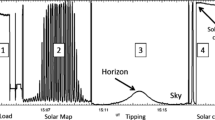Abstract
THE observational evidence of an explosive phase in the development of the solar flare, as reported by Athay and Moreton1, is of great interest. This phase appears after the commencement of the flare, is well defined, and thus provides a stage in the evolution of certain flares which may be of significance for examination of flare-related phenomena, such as solar noise bursts, etc. The Athay and Moreton paper lists eleven selected flares with ‘explosive’ phases. Two of these flares occurred outside the normal observing period at Ottawa, but the remaining nine can be compared with 10.7-cm. solar noise bursts observed at Ottawa. These cases, while few in number, sharpen the already well-established close relationship between flares and 10.7-cm. radio bursts which have been derived from other work done on the Ottawa data2.
Similar content being viewed by others
References
Athay, R. G., and Moreton, G. E., Astrophys. J., 133, 3 (1961).
Dodson, H. W., Hedeman, E. R., and Covington, A. E., Astrophys. J., 119, 3 (1954).
Covington, A. E., and Harvey, G. A., J. Roy. Astro. Soc., Canada, 52, 161 (1958).
Author information
Authors and Affiliations
Rights and permissions
About this article
Cite this article
COVINGTON, A., HARVEY, G. Coincidence of the Explosive Phase of Solar Flares with 10.7-cm. Solar Noise Bursts. Nature 192, 152–153 (1961). https://doi.org/10.1038/192152a0
Issue Date:
DOI: https://doi.org/10.1038/192152a0
- Springer Nature Limited
This article is cited by
-
Some studies on solar microwave bursts in relation to the phases of the associated H?-flares and their spectral nature
Solar Physics (1975)
-
Decrease of 2800 MHz solar radio emission associated with a moving dark filament before the flare of May 19, 1969
Solar Physics (1973)
-
The impulsiveness of microwave bursts and its association with sunspot types
Solar Physics (1971)
-
The explosive phase of solar flares
Solar Physics (1971)
-
Theory of solar bursts
Solar Physics (1967)





